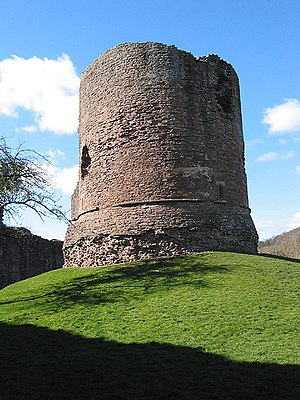Skenfrith Castle
| Skenfrith Castle | ||
|---|---|---|
|
The Keep of Skenfrith Castle |
||
| Alternative name (s): | Castell Ynysgynwraidd | |
| Creation time : | 12th Century | |
| Conservation status: | ruin | |
| Geographical location | 51 ° 52 '40.1 " N , 2 ° 47' 20" W | |
|
|
||
Skenfrith Castle ( Welsh Castell Ynysgynwraidd ) is a ruined castle in Monmouthshire , Wales . The ruin, classified as a Grade II * cultural monument and protected as a Scheduled Monument , is located in the small village of Skenfrith 9 km northwest of Monmouth and 19 km northeast of Abergavenny . Together with Grosmont and White Castle , it belongs to the so-called Three Castles, which as a castle triangle secured the border between Wales and England in the Middle Ages and whose history is closely linked. Since the 12th century, the three castles formed a common rule.
history
The English King Henry II had a first castle built around 1160 to secure the main road between Herefordshire and South Wales. In 1187 the king commissioned Ralph de Grosmont to convert the castle into a stone fortress. The construction remained unfinished, however, as the king already assessed the castle as no longer important in 1188 and stopped further construction. In 1193, William de Braose , the sheriff of Herefordshire at the time, had the unfinished castle re-fortified with wood and earth fortifications and used the complex as a prison. Like Grosmont and White Castle, King Johann Ohneland gave the castle to Hubert de Burgh in 1201 . After de Burgh was taken prisoner seriously wounded in France in 1205, the king gave the castle directly to William de Braose in 1206 . In 1208 it fell back to the crown after the de Braose rebellion. In 1215 Reginald de Braose , a son of Williams, was able to conquer it with the help of the Welsh prince Llywelyn ap Iorwerth , but in 1219 he had to return it to Hubert de Burgh. De Burgh continued to expand the castle, but a flood of the River Monnow destroyed the unfinished structure in 1220. De Burgh had a new one built on the remains of the old castle. Between 1228 and 1230 the castle was briefly owned by John de Braose , a grandson of Williams de Braose, but then fell back to de Burgh. In 1239 de Burgh had to give the castle back to the crown. Henry III. gave it to his son Eduard in 1254 and to his younger son Edmund of Lancaster in 1267 . The castle remained in the possession of the descendants of Edmunds, the Earls and Dukes of Lancaster, until it fell back to the crown with Heinrich Bolingbroke's accession to the throne in 1399. During the rebellion of Owain Glyndŵr , the castle was fought over again between 1404 and 1405, after which it fell into disrepair and was already in ruins in 1538. In 1825 the Duchy of Lancaster sold the castle to the Duke of Beaufort . In the 1920s, the ruins became state property. Excavations took place in the 1950s, and the remains of the 1220 flooded buildings were also uncovered. Today the castle is owned by the National Trust , but the ruin is managed by Cadw and is freely accessible during the day.
investment
The castle is located directly on the western bank of the Monnow. Except for the side facing the river, the castle was surrounded by a 6 m deep masonry moat, which, however, was filled. The complex consists of a circular wall that encloses an irregular square and round or semicircular corner towers and another semicircular tower on the west side. The wall on the east side and probably the north-eastern tower date from the 12th century, the other parts of the wall come from the expansion that took place after 1220. The simple gatehouse on the north side has been almost completely destroyed. The castle courtyard was filled with gravel after the flood of 1220. Only the foundations of the living hall and the other buildings on the western and southern walls have survived, including the foundations of the hall, which was flooded in 1220 and which was later filled in. In the middle of the castle courtyard rises the free-standing round keep , which was built around 1230 on an artificial hill to make it difficult for siege engines to approach .
literature
- Adrian Pettifer: Welsh castles. A guide by counties . Boydell & Brewer, Woodbridge 2000, ISBN 978-0-85115-778-8 , pp. 140-142
Web links
Individual evidence
- ^ Cadw Listed Building Database Record: Skenfrith Castle. Retrieved April 8, 2014 .


